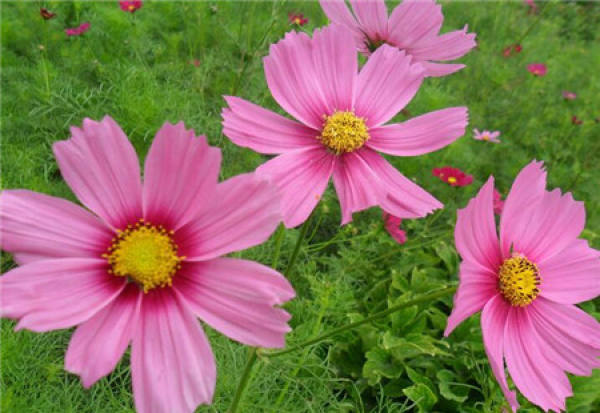Persian chrysanthemum is an annual herb with erect slender stems, many branches, smooth stems or hairy hairs. Single leaf opposite, about 10 cm long, bipinnately divided, lobes narrowly linear, entire margin toothless.
The capitulum is borne on a long and slender peduncle, terminal or axillary, with a stem of 5-8 cm. There were 2 layers in the total package film, and the inner edge was membranous. There are 8 petals, white, pink and crimson.
The tube flowers are yellow in the central part of the flower plate. Achenes have rafters, the life span of seeds is 3-4 years, and the weight of 1000 seeds is 6G. From summer to autumn, the seeds are crescent shaped.
The horticultural varieties include white flower, big flower and purple red flower. The horticultural varieties are divided into two systems: early flower type and late flower type, as well as single and double petals.

Gesanghua, also known as gesangmeiduo, is widely debated about the specific plant species. In Tibetan, "Gesang" means "good time" or "happiness", and "Meiduo" means "flower", so Gesang flower is also called "happiness flower", which has long been pinning on the Tibetan people's good feelings of looking forward to happiness and auspiciousness.
According to the relevant literature research and interviews with key figures, it is said that a large number of Tibetan films, songs, and magazines that are regarded as gesanghua are not the real gesanghua.
In a broad sense, "gesangmeiduo" is likely to be the synonym of the most tenacious wild flower on the plateau, while in terms of botanical characteristics, asters in Compositae and cuiju, a common cultivated plant from Lhasa to Changdu, both conform to the characteristics of qualified mulberry flowers.

In Tibet, people often express and express their beautiful feelings through gesanhua, and spread many songs and stories praising gesanhua. Gesanghua has a high position in the hearts of the Tibetan people, and is regarded by the Tibetan people as a holy flower symbolizing love and auspiciousness.
Some plants called gesanghua by Tibetan people: bosju, cuiju, alpine azalea, jinlumei, etc.
That is to say, bossy can be Gesang flower, but Gesang flower contains many kinds of plants. People often put flowers with good wishes, so this Gesang flower, can be the chrysanthemum on the side of the road, can also be the plum blossom.
Gesanghua is a big category, but bosju is just one of them. Now do you understand the relationship between bosju and gesanghua?
